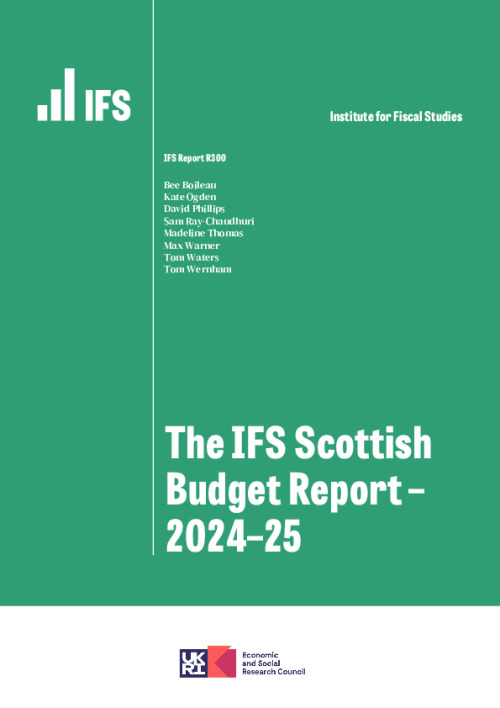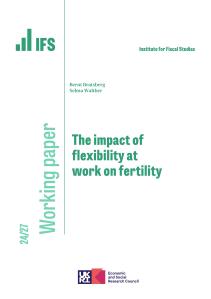The Scottish Government’s Budget for 2024–25 takes place at a time of particular uncertainty about the future funding environment. UK government spending plans both for the coming year and for later years seem likely to be topped up, but when and by how much is unclear. The current UK government wants to announce tax cuts before the upcoming general election, but history tells us that we should not be surprised if taxes were to rise post-election. And the performance of Scotland’s devolved tax revenues – in particular given recent and planned tax policy changes – is uncertain. Taken together, these factors make the task of planning Scottish tax and spending decisions particularly challenging – an issue discussed in an IFS comment published alongside this report.
At the time the Budget Bill was presented to the Scottish Parliament, the funding available for day-to-day (resource) spending in 2024–25 was set to be 2.2% higher in real terms than originally budgeted for in 2023–24. However, accounting for in-year top-ups to budgets in the current financial year – most notably for health, justice and local government – currently planned public service resource spending is set to be 0.6% lower in real terms in 2024–25 than in the current financial year. As the Scottish Government has previously argued, next year’s plans are likely to be topped up too, but they have not yet been. And as parliamentarians and other stakeholders work out how next year’s plans should be amended if more funding becomes available (or, indeed, if it does not), the best starting point for debate is the latest picture for changes in funding.
Additional UK government funding and much stronger forecasts for the net contribution of Scotland’s devolved taxes (and particularly income tax) to the budget mean that public service resource funding in 2024–25 is set to be 6.7% higher in cash terms than the initial plans set out in the May 2022 Resource Spending Review. However, higher-than-expected inflation has offset nearly all of this increase in cash budgets: public service resource funding is set to be just 0.7% higher in real terms than expected in May 2022. That it has increased at all is thanks to the forecast improvements in Scotland’s net income tax revenue position – the top-ups to UK government funding have lagged behind inflation. The rest of the UK, which has not seen a boost to public spending as a result of improved income tax revenue performance, will see budgets in 2024–25 that are lower in real terms than expected two years ago.
Looking further ahead, further forecast improvements in Scotland’s net income tax revenue position are set to boost funding, particularly in 2025–26. But UK government funding is likely to be constrained, which means that after a 2.2% real-terms increase in 2025–26, current projections imply increases in public service resource funding averaging just 0.6% per year in the following three years. There is significant uncertainty around these projections, and the eventual picture could turn out somewhat more or less challenging – but the Scottish Government will almost certainly face tricky trade-offs as it allocates funding between different services.
The rest of this report proceeds as follows.
Chapter 2 looks at the outlook for tax and spending in 2024–25, considering both changes in underlying forecasts and the policy choices made by the Scottish Government. It finds that, compared with plans set out in the 2022 Spending Review, all major areas of spending are set to receive more in cash terms, driven by a combination of higher UK government funding and stronger devolved tax revenue performance (only a small part of which relates to tax policy changes). However, the impact of inflation staying higher for longer means that, in real terms, funding for health and social care is set to be lower next year than expected back in May 2022. Current plans also imply that health and social care spending in the coming year will be lower than the latest plans for 2023–24.
Chapter 3 turns to the medium-term funding outlook, and the tricky choices facing the Scottish Government from 2025–26. It shows that while current projections suggest that year should provide a decent real-terms boost to funding, the following three years could be very tight, necessitating cuts to many services. The chapter also illustrates how uncertain the medium-term funding outlook facing the Scottish Government is, driven both by uncertainty about UK government funding and by difficulty in forecasting Scotland’s devolved tax revenues. In this context, it may make sense to align Scotland’s medium-term spending planning timelines with the UK government’s Spending Review timelines, as is done in Wales.
Chapter 4 looks at Scottish healthcare spending, staffing and activity. It shows that Scotland’s health spending grew by less than England’s in the 2000s and 2010s, and that although currently budgeted spending in 2024–25 is set to be higher per person than in England, it is set to be lower than in Wales (a reversal of the picture for the first two decades of the 21st century). It also shows that while NHS staffing has substantially increased since prior to the pandemic, the number of patients being treated remains lower. Unless it is reversed, this seeming fall in productivity – which has also been seen in the English NHS – poses major challenges in tackling growing waiting lists, improving health, and funding the Scottish NHS in coming years.
Chapter 5 then looks at the Scottish higher education funding system. Increases in the amount students can borrow to fund living costs will meet the Scottish Government’s commitment to provide a total package of support ‘the equivalent of the Living Wage’. And it will do so at no cost to the Scottish Government’s main budget: students will repay most of the extra loans and the share written off will be funded by the UK government. However, addressing the real-terms decline in funding for teaching seen over the last 10 years will be more challenging under Scotland’s model of free tuition. Moving away from this model would see the costs faced by students themselves increase significantly, and could come at the risk of the UK government deciding the cost of student loans is not comparable to that in England’s system, and so refusing to cover it.
Chapter 6 offers some brief concluding remarks.

















